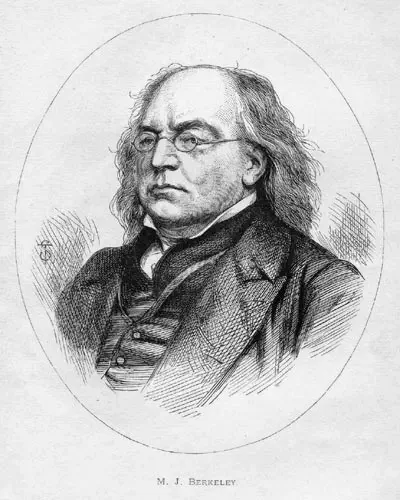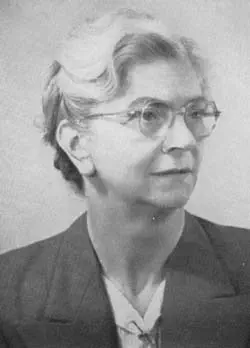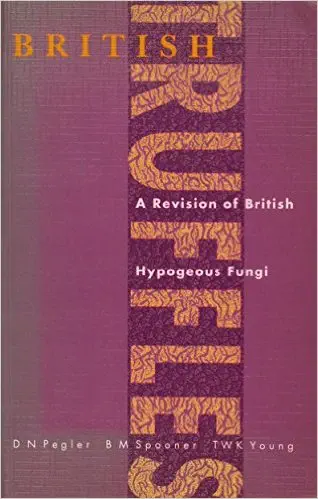There have been three distinct phases of study of truffles in Britain, the first being around 150 years ago. Since the two principal collectors were in Bristol, our understanding of species distributions today is still to a great extent based on their work and focus on Avon, Somerset and Gloucestershire.
Phase 1 – The Rev. M.J. Berkeley and C.E. Broome.
Between 1846 and 1875 The Rev. M.J. Berkeley and C.E. Broome recorded and described most of the species known today.
The Rev. M.J. Berkeley

Miles Joseph Berkeley (1 April 1803 – 30 July 1889) was an English cryptogamist and clergyman, and one of the founders of the science of plant pathology.
He was well known as a systematist in mycology with some 6000 species of fungi being credited to him,
As the founder of British mycology, his significant work is contained in the account of native British fungi in Sir William Jackson Hooker’s British Flora (1836), in his Introduction to Cryptogamic Botany (1857), and in his Outlines of British Fungology (1860). His herbarium at the Royal Botanic Gardens, Kew, is one of the world’s most extensive, containing over 9000 specimens as well as numerous notes and sketches.
Mr. C.E. Broome
Christopher Edmund Broome (24 July 1812 – 15 November 1886) was a British mycologist.
Broome developed an expertise in fungi, sending many of his collections to the Rev. M.J. Berkeley. Together, Berkeley and Broome published a series of “Notices of British Fungi” over a 37-year period, jointly describing no less than 550 new species.
His particular interest was in truffles and truffle-like fungi, but he collected widely and carefully. On his death, his herbarium contained some 40,000 fungal specimens, which are now at the Royal Botanic Gardens, Kew.
Broome became a fellow of the Linnean Society in 1866. The fungal genera Broomeia and Broomella were named after him, together with over a dozen fungal species, including the truffle-like Melanogaster broomeanus.
Phase 2 – Professor Lilian E Hawker

Professor Lilian Hawker and her students between 1948 and 1953 undertook extensive surveys for truffles and truffle-like fungi and these lead to publication of a revised species list in 1954:
Lilian E. Hawker (1954), British Hypogeous Fungi, Phil. Trans. Roy. Soc., London, Sr B, 237: 429-546
This was revised in 1974:
Lilian E. Hawker (1974), Revised annotated list of British hypogeous fungi, Transactions of the British Mycological Society. Volume 63, Issue 1, 2 August 1974, 67-76
Lilian Edith Hawker (19 May 1908 – 5 February 1991) was a British mycologist, known for her work on fungal physiology, particularly spore production. She was an expert on British truffles, and also published in the fields of plant physiology and plant pathology. She was also known for her contributions to education in mycology. Most of her career was spent at the botany department of the Imperial College of Science and Technology (1932–45) and the University of Bristol (1945–73), where she held the chair in mycology (1965–73) and was dean of the science faculty (1970–73). She served as president of the British Mycological Society, and was elected an honorary member of that society and of the Mycological Society of America.
In 1948, she started to investigate the distribution in Britain of hypogeous fungi, known as truffles: fungi with underground fruiting bodies. She is said to have “revived the study of truffles in England”; before her work this group had not been studied since the Victorian era, and they were believed to be rare in the country. In 1948–59, she found 1200 specimens from at least 60 species within 25 miles of Bristol. Her research resulted in a 1954 monograph, and was described in 2005 as still “unequalled.”
Phase 3 – The British Mycological Society & Royal Botanic Gardens
The British Mycological Society decided to revive interest and during the 1980s held a number annual, short residential truffle hunts. This revival stimulated the need for a revised account of all truffles and false truffles, taking into the account the considerable taxonomic developments since Hawker’s 1974 paper. The result of this study was the publication:
N. Pegler, B. M. Spooner & T. W. K. Young (1993), British Truffles: Revision of British Hypogeous Fungi, Royal Botanic Gardens.

One name of note since the above publication is Caroline Hobart, an active member of the British Mycological Society. She is specifically interested in the study of underground fungi that grow in the UK. In the last 20 years, she has increased the British “underground mushroom” / “truffle” list by over 10% and has many more un-described species to describe and name.
This web page uses material from the following Wikipedia articles which are released under the Creative Commons Attribution-Share-Alike License 3.0. Content may have been omitted from the original, but no content has been changed or extended.
